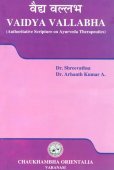Trayi, Trayī: 16 definitions
Introduction:
Trayi means something in Hinduism, Sanskrit, the history of ancient India, Marathi, Hindi. If you want to know the exact meaning, history, etymology or English translation of this term then check out the descriptions on this page. Add your comment or reference to a book if you want to contribute to this summary article.
In Hinduism
Shaktism (Shakta philosophy)
Source: Wisdom Library: ŚāktismTrayī (त्रयी, “Three [Vedas]”):—One of the female offspring from Mahākālī (tamas-form of Mahādevī). Also known as Sarasvatī. Mahākālī is one of the three primary forms of Devī, the other two being Mahālakṣmī and Mahāsarasvatī. Not to be confused with Kālī, she is a more powerful cosmic aspect (vyaṣṭi) of Devi and represents the guṇa (universal energy) named tamas. Also see the Devī Māhātmya, a Sanskrit work from the 5th century, incorporated into the Mārkaṇḍeya-Purāṇa.

Shakta (शाक्त, śākta) or Shaktism (śāktism) represents a tradition of Hinduism where the Goddess (Devi) is revered and worshipped. Shakta literature includes a range of scriptures, including various Agamas and Tantras, although its roots may be traced back to the Vedas.
Dharmashastra (religious law)
Source: Wisdom Library: Dharma-śāstraTrayī (त्रयी) refers to “Vedic triad”. It represents a branch of knowledge, dealing with Dharma and Adharma (right and wrong), of which the King should be familiar with. The word is used throughout Dharmaśāstra literature such as the Manusmṛti. (also see the Manubhāṣya verse 7.43)

Dharmashastra (धर्मशास्त्र, dharmaśāstra) contains the instructions (shastra) regarding religious conduct of livelihood (dharma), ceremonies, jurisprudence (study of law) and more. It is categorized as smriti, an important and authoritative selection of books dealing with the Hindu lifestyle.
Vaishnavism (Vaishava dharma)
Source: ISKCON Press: GlossaryTrayī (त्रयी).—The three Vedas. (Ṛg, Sāma and Yajur), which explain fruitive activities for material benefits.

Vaishnava (वैष्णव, vaiṣṇava) or vaishnavism (vaiṣṇavism) represents a tradition of Hinduism worshipping Vishnu as the supreme Lord. Similar to the Shaktism and Shaivism traditions, Vaishnavism also developed as an individual movement, famous for its exposition of the dashavatara (‘ten avatars of Vishnu’).
Purana and Itihasa (epic history)
Source: archive.org: Puranic EncyclopediaTrayī (त्रयी).—Veda. Formerly only three Vedas, Ṛgveda, Yajurveda and Sāmaveda were recognised and so Trayī meaning group of three was used to denote the Vedas. (See under Veda).
Source: Cologne Digital Sanskrit Dictionaries: The Purana Index1a) Trayī (त्रयी).—A daughter of Savitā.*
- * Bhāgavata-purāṇa VI. 18. 1.
1b) A Vidyā;1 symbolical of Devī;2 said to be the body of Hari;3 forbidden to women, śūdras and fallen Brahmanas;4 issued from Brahmā;5 one Veda became three for Purūravas at the commencement of the Tretāyuga;6 unknown to Puṣkaradvīpa.7
- 1) Vāyu-purāṇa 49. 118; 59. 36; 61. 167; 67. 27; Viṣṇu-purāṇa V. 10. 27.
- 2) Viṣṇu-purāṇa I. 9. 121.
- 3) Ib. II. 11. 11; III. 18. 15.
- 4) Bhāgavata-purāṇa I. 4. 25.
- 5) Ib. III. 12. 44.
- 6) Ib. IX. 14. 48-49.
- 7) Brahmāṇḍa-purāṇa II. 19. 122; 32. 40; 35. 195; III. 4. 24; Viṣṇu-purāṇa II. 4. 83.

The Purana (पुराण, purāṇas) refers to Sanskrit literature preserving ancient India’s vast cultural history, including historical legends, religious ceremonies, various arts and sciences. The eighteen mahapuranas total over 400,000 shlokas (metrical couplets) and date to at least several centuries BCE.
Arthashastra (politics and welfare)
Source: Knowledge Traditions & Practices of India: Society State and Polity: A SurveyTrayī (त्रयी) refers to the three Vedas (Sama, Ṛg and Yajur) and represents one of the four classes of knowledge needed to run a state according to Kauṭilya’s Arthaśāstra (4th century BCE): one of the most influential treatises of political science. These texts (trayī) establish the four classes (varṇas) and the four orders (āśramas).

Arthashastra (अर्थशास्त्र, arthaśāstra) literature concerns itself with the teachings (shastra) of economic prosperity (artha) statecraft, politics and military tactics. The term arthashastra refers to both the name of these scientific teachings, as well as the name of a Sanskrit work included in such literature. This book was written (3rd century BCE) by by Kautilya, who flourished in the 4th century BCE.
India history and geography
Source: Cologne Digital Sanskrit Dictionaries: Indian Epigraphical GlossaryTrayī.—(SII 1), the three Vedas. Note: trayī is defined in the “Indian epigraphical glossary” as it can be found on ancient inscriptions commonly written in Sanskrit, Prakrit or Dravidian languages.

The history of India traces the identification of countries, villages, towns and other regions of India, as well as mythology, zoology, royal dynasties, rulers, tribes, local festivities and traditions and regional languages. Ancient India enjoyed religious freedom and encourages the path of Dharma, a concept common to Buddhism, Hinduism, and Jainism.
Languages of India and abroad
Marathi-English dictionary
Source: DDSA: The Molesworth Marathi and English Dictionarytrayī (त्रयी).—f S An aggregate of three, a trio; but used esp. of father, grandfather, and great grandfather; and of mother, grandmother, and great grandmother; and of the three Vedas collectively, omitting the atharvaṇa. 2 The second of the four divisions of rājanīti, explained as dharmavidyā or dharmādharmavicāra Consideration of lawful and unlawful, of equitable and inequitable, of allowable and not allowable. See ānvīkṣikī, vārttā, daṇḍanīti. trayī uddharaṇēṃ (To deliver from hell one's father, grandfather &c.) To curse or revile them. trayīmadhyēṃ ugavalēlā (One proficient in the three Vedas or sciences.) A term for a thief, slanderer, and fornicator.
Marathi is an Indo-European language having over 70 million native speakers people in (predominantly) Maharashtra India. Marathi, like many other Indo-Aryan languages, evolved from early forms of Prakrit, which itself is a subset of Sanskrit, one of the most ancient languages of the world.
Sanskrit dictionary
Source: DDSA: The practical Sanskrit-English dictionaryTrayī (त्रयी).—
1) The three Vedas taken collectively (ṛgyajuḥsāmāni); त्रयीमयाय त्रिगुणात्मने नमः (trayīmayāya triguṇātmane namaḥ) K.1; त्रयीवर्जमितरा विद्याः परिपाठितौ (trayīvarjamitarā vidyāḥ paripāṭhitau) Uttararāmacarita 2; Manusmṛti 4.125.
2) A triad, triplet; व्यद्योतिष्ट सभावेद्यामसौ नरशिखित्रयी (vyadyotiṣṭa sabhāvedyāmasau naraśikhitrayī) Śiśupālavadha 2.3.
3) A matron or married woman whose husband and children are living.
4) Intellect, understanding.
5) The part of the श्रुति (śruti), pertaining to ceremonial acts and sacrifices (karmakāṇḍa); Bhāgavata 7.6.26.
Source: Cologne Digital Sanskrit Dictionaries: Shabda-Sagara Sanskrit-English DictionaryTrayī (त्रयी).—f. (-yī) 1. The three Vedas collectively, that is, omitting the Atharvan, which not being a text book for the customary religious rites of the Hindus, is considered very commonly rather as an appendix to the other three, than a fourth work of equal authority. 2. A matron, a married woman who has children living. 3. Intellect, understanding. 4. A plant, (Conyza serratula.) E. tri three, ayac or ṭayap substitated for the final, fem. affix ṅīp .
Source: Cologne Digital Sanskrit Dictionaries: Monier-Williams Sanskrit-English Dictionary1) Trayī (त्रयी):—[from traya] a f. idem See śata-
2) [v.s. ...] = yī vidyā, [Gautama-dharma-śāstra; Manu-smṛti] etc.
3) [v.s. ...] the [Buddhist literature] triad (Buddha, Dharma, and Saṃgha), [Harṣacarita viii]
4) [v.s. ...] summit, [Bālarāmāyaṇa i, 28]
5) [v.s. ...] a woman whose husband and children are living, [cf. Lexicographers, esp. such as amarasiṃha, halāyudha, hemacandra, etc.]
6) [v.s. ...] Venonia anthelminthica, [cf. Lexicographers, esp. such as amarasiṃha, halāyudha, hemacandra, etc.]
7) [v.s. ...] su-mati, [cf. Lexicographers, esp. such as amarasiṃha, halāyudha, hemacandra, etc.]
8) [from traya] b f. of ya.
Source: Cologne Digital Sanskrit Dictionaries: Yates Sanskrit-English DictionaryTrayī (त्रयी):—(yī) 3. f. The three vedas, omitting the 4th or Atharvan; a motion; intellect; a plant.
Source: DDSA: Paia-sadda-mahannavo; a comprehensive Prakrit Hindi dictionary (S)Trayī (त्रयी) in the Sanskrit language is related to the Prakrit word: Taī.
[Sanskrit to German]
Sanskrit, also spelled संस्कृतम् (saṃskṛtam), is an ancient language of India commonly seen as the grandmother of the Indo-European language family (even English!). Closely allied with Prakrit and Pali, Sanskrit is more exhaustive in both grammar and terms and has the most extensive collection of literature in the world, greatly surpassing its sister-languages Greek and Latin.
Hindi dictionary
Source: DDSA: A practical Hindi-English dictionaryTrayī (त्रयी):—(nf) a trio, trinity; (a) trimerous.
...
Kannada-English dictionary
Source: Alar: Kannada-English corpusTrayi (ತ್ರಯಿ):—
1) [noun] = ತ್ರಯೀ [trayi].
2) [noun] a set or group of three things.
--- OR ---
Trayī (ತ್ರಯೀ):—[noun] the three Vedas (Řg, Yajur and Sāma Vedas).
Kannada is a Dravidian language (as opposed to the Indo-European language family) mainly spoken in the southwestern region of India.
See also (Relevant definitions)
Starts with: Trayibhashya, Trayideha, Trayidhamavant, Trayidhamavat, Trayidharma, Trayidharmma, Trayimaya, Trayimukha, Trayimurtimant, Trayin, Trayinishkarsha, Trayirashika, Trayisamvarana, Trayisanu, Trayitanu, Trayivida, Trayividya, Trayiviparita, Trayivit.
Ends with: Caturmasakatrayi, Kathatrayi, Lokatrayi, Prasthanatrayi, Shatatrayi, Vedatrayi.
Full-text (+40): Trayimukha, Trayitanu, Traya, Trayidharma, Trayimaya, Trayivida, Vedatrayi, Lokatraya, Dvijabandhu, Anvikshiki, Veda, Trayidhamavat, Trayideha, Trayibhashya, Trayinishkarsha, Trayyanta, Tai, Shatatrayi, Bhagavatapadyatrayivyakhyana, Traivida.
Relevant text
Search found 60 books and stories containing Trayi, Trayī, Trayee; (plurals include: Trayis, Trayīs, Trayees). You can also click to the full overview containing English textual excerpts. Below are direct links for the most relevant articles:
Vedic influence on the Sun-worship in the Puranas (by Goswami Mitali)
Part 2 - The Sacrifices Related to the Sun-god Dealt with in the Purāṇas < [Chapter 5 - Rituals Related to the Sun-Worship in the Purāṇas]
Part 1 - Veda, the Storehouse of Knowledge < [Chapter 1 - Vedic Concept of God and Religion]
Social Message of the Upanishads (by Sanchita Kundu)
Chapter 4.1 - Political Picture of the Upanishads
The Brahmanda Purana (by G.V. Tagare)
Chapter 4 - Pronunciation of a curse on Jayas < [Section 3 - Upodghāta-pāda]
Chapter 14 - Purification rites and the Śrāddha ritual < [Section 3 - Upodghāta-pāda]
Chapter 1 - Description of the dissolution of the Universe (a) < [Section 4a - Upasaṃhāra-pāda]
Bhakti-rasamrta-sindhu (by Śrīla Rūpa Gosvāmī)
Verse 3.3.63 < [Part 3 - Fraternal Devotion (sakhya-rasa)]
Verse 2.5.23 < [Part 5 - Permanent Ecstatic Mood (sthāyī-bhāva)]
Verse 2.5.24 < [Part 5 - Permanent Ecstatic Mood (sthāyī-bhāva)]
Historical Elements in the Matsya Purana (by Chaitali Kadia)
Ancient Depictions of the Purāṇas < [Chapter 1 - An Introduction of the Purāṇas]
Sivaprakasam (Study in Bondage and Liberation) (by N. Veerappan)
Means of release in Advaita < [Chapter 6 - Means to Release]
Related products
